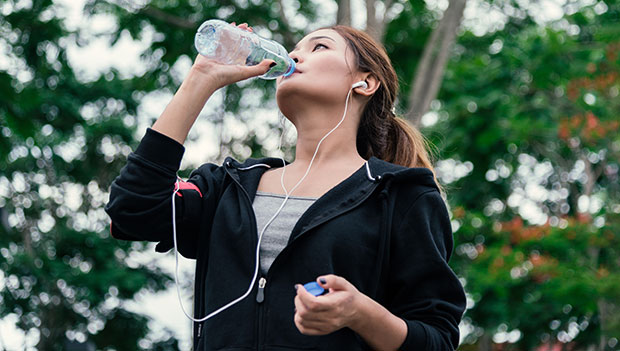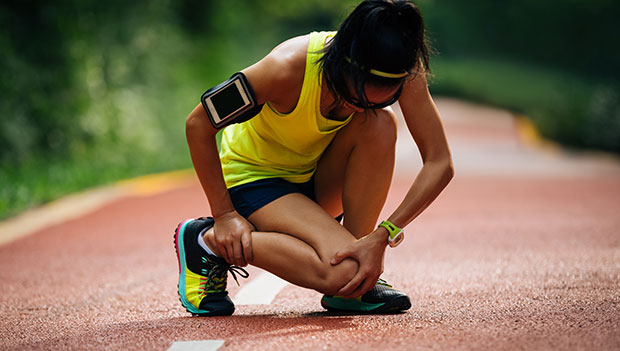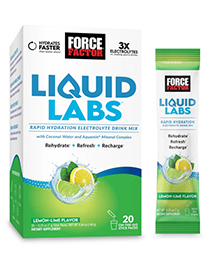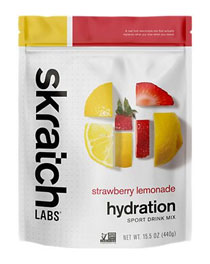
By clicking on the product links in this article, we may receive a commission fee at no cost to you, the reader. Sponsorships and affiliate commissions help support our research so we can help you find the best products. Read our full affiliate disclosure here.
Having raced as a professional triathlete for a decade and more recently dabbled in ultra running, I’ve had my fair share of running cramps. Being at the mercy of a locked calf muscle or a hamstring that feels like it’s about to ping is no fun. I started racing triathlon in 2005 as an age-grouper and was often plagued with cramps while running and in the pool.
With minor tweaks to my daily nutrition—such as adding salt to meals and making sure I drank enough water and electrolytes (see recommendations below)—my cramping problems didn't persist for too long. When my training volume was high, I was also meticulous about getting regular massages and doing basic maintenance, such as foam rolling and mobility work pre- and post-training. By taking care of my nutrition and body, the likelihood of suffering from cramps while running seemed to drop significantly. I know not all athletes are as fortunate, though, and it can take a lot of patience and diligence to rid yourself of muscle cramps from run training and racing.
Knowing how to prevent cramps while running can help save you from pain and discomfort and help you hit your training and racing potential. The pain of cramps while running can be debilitating, typically forcing you to slow down or even stop. Now where’s the fun in that? Avoiding cramps while running can help you maximize your training, performance, and enjoyment.
Before diving into possible solutions, let’s first look at what causes cramps and why you might be experiencing them.
Our Top Electrolyte Picks from The Vitamin Shoppe
- Liquid I.V. Hydration Multiplier
- Nuun Sport Hydration
- Skratch Labs Hydration Sport Drink Mix
- Force Factor Liquid Labs Hydration
- Bucked Up Hydration
- Kaged Hydra-Charge
What Causes Cramps While Running?
The causes of cramps while running have been the focus of research for some time now, with two theories taking the lead. The first theory focuses on dehydration by pointing to an imbalance in fluids and electrolytes (calcium, magnesium, potassium, and sodium).(1) Over the years, the research has pointed toward a second theory as studies began showing that some athletes suffer cramps when fluid intake and electrolyte levels were adequate and inadequate.(2) Therefore, the second—and newest—theory involves back-and-forth communication between the muscles and the nervous system.(3) Your neuromuscular system, that is, your nerves and muscles, are in constant conversation. When you push harder or dig deeper than your body is prepared for, your brain signals your body to stop to prevent excessive damage from being caused to the muscle. It’s at this time that cramps can occur.
Anyone who has experienced a muscle cramp during a race will know how debilitating it can be, so having a strategy for dealing with cramps that includes sensible pacing and preparation—along with adequate fluid and electrolyte intake—may help with cramp prevention.
I asked the opinion of certified cycling coach and physiologist Ryan Kohler, who says it can be a mix of factors—fluids, electrolytes, fueling, and fitness—that can cause cramps. When he is preparing athletes for events, he says they must be well-fueled with their glycogen stores “topped up” since relatively small levels of glycogen depletion can lead to reduced calcium release within muscle cells, changing muscle force output and endurance, ultimately leading to that painful and involuntary muscle contraction we know as cramping.(4)

Your fluid intake and electrolyte balance are equally as important, as it helps to ensure adequate blood plasma volume.(5) Drinking beverages that contain electrolytes before your run (and during your run if you are exercising for a long duration and/or in hot, humid conditions) can help avoid dehydration-related muscle cramps.(6) Aim to hydrate with about 16 ounces (500mL or 2.5 cups) of fluids one to two hours before your run. For runs longer than 90 minutes, you could consider taking on a low-carbohydrate electrolyte drink (with less than 4% carbohydrate) containing glucose or sucrose (or both), plus added sodium and potassium during your workout. Always be sure to test different hydration or fueling practices thoroughly in training before a race.
Yet even with your fluids, electrolytes, and fuel taken care of, “You can still outpace your fitness,” Kohler says. “This relates to the neuromuscular theory that you might go out too hard, accumulating more work than your body is prepared for. In that case, you might find that to be [the] cause of cramps in some athletes. I've found that when we can improve fitness (e.g., with threshold speed work), we can hold off cramps longer.”
There could be a genetic predisposition to cramping for some athletes too. Kohler says, “The research also suggests that those athletes that experience exercise-induced muscle cramps can tend to expect them to return. There is a historical significance to them.”
How to Prevent Cramps While Running
Note: These tips are my personal recommendations amassed from many years of running.
- Ensure you are optimally fueled and hydrated, which includes eating a balanced diet and incorporating adequate sodium, calcium, magnesium, and potassium.
- Know what your body can do. Push mostly within your limits by establishing and practicing a pacing strategy.
- If you have a prior history of cramping, work with a coach or sports nutritionist to analyze your previous sessions and/or races to see if you can find some common threads that might underpin habits or factors that lead to cramps.
- Get a sweat test. This helps you understand how much fluid and electrolytes you lose during exercise. If you are a heavy sweater you can adjust your electrolyte intake accordingly. Conversely, if you only lose a low amount of sodium in your sweat this knowledge can also prove useful for your training and racing (as taking on more electrolytes than you need can lead to GI distress when running).(7)
- Ensure adequate rest, recovery, and sleep between workouts.
- Stretch and warm up well before you run.
- If possible, get regular massage to help prevent muscles from getting tight and sore.
- Incorporate strength training into your program to ensure your muscles are resilient, durable, and ready for running.
If you're looking for electrolytes to help boost your hydration levels, check out our list of the best electrolyte products at The Vitamin Shoppe:
- Liquid I.V. Hydration Multiplier
- Nuun Sport Hydration
- Skratch Labs Hydration Sport Drink Mix
- Force Factor Liquid Labs Hydration
- Bucked Up Hydration
- Kaged Hydra-Charge
Where Do You Suffer Cramps While Running?

Runners will typically suffer cramps in the muscles they are using and heavily engaging when running, namely their thighs, calves, and abdominal muscles.(1) Side cramps caused by abdominal muscle cramping can also be painful and debilitating, so knowing what causes and how to prevent side cramps may prove helpful.
Kohler says, “When looking at ways to prevent side cramps, it’s important to think about the respiratory muscles that are used for inhalation and exhalation. That’s where we can see components of respiratory training (or lack of training) show up. When I ran shorter distances in my younger days, I would often get side cramps in 5K and 10K races, which also required a high respiratory rate and large amounts of air.”
With forced inhalation and exhalation, those respiratory muscles can get as fatigued as other muscles and can result in the same type of pain as with high exertion. Breath work can be extremely helpful in learning to prevent cramps while running: If your breathing is too shallow, you won’t deliver enough oxygen to the muscles that need it. Working on your breathing when not running (i.e., at rest) can also prove beneficial, helping to downregulate your parasympathetic nervous system, the “rest and digest” state, which helps promote exercise recovery.
How to Cope with Cramps When Running
If the worst happens and you suffer a cramp during a race, there are several ways to address it to help ensure you’re soon back in action. The first and most obvious is to stop or slow down, which most runners don’t want to do, but often, you might not have much choice. Kohler said: “Slowing your pace will help you reduce the stress on your neuromuscular system, allowing you to offend the muscles a little less.”
Kohler also suggests gentle stretching or self-massage as another solution to help cope with cramps when running.(8) “I haven’t seen a lot of research around cramps and stretching, but I know that the in-the-field anecdotal evidence is strong. Just be sure to ease into the stretch slowly and gently.”
Research, in fact, does show that moderate stretching alone can help to alleviate many muscle cramps.(9) If you are looking for ways to prevent leg cramps while running, for example, then a gentle stretch of the affected muscle can help, as can massaging the area until the pain dissipates.
If you suffer from stomach cramps during running, you could look carefully at the timing of your meals around your workouts. Exercising affects the gastrointestinal tract in a variety of ways, like delaying the time it takes for the stomach to empty the last meal consumed, which may or may not cause additional discomfort.(10) Try giving yourself a longer break after meals before going on a run to see if your stomach cramps are reduced.
When to See a Doctor for Running Cramps
Most exercise-induced cramping issues should resolve—or improve, at least—by being diligent with your fluid and electrolyte intake and not pushing yourself too far beyond your regular pacing strategy. “I would typically advise athletes or clients to see a healthcare professional if cramps are occurring outside of running or if symptoms are not resolved through some of the tried and true methods we are familiar with,” Kohler suggests.
My Final Takeaway
While there are no guarantees when it comes to eliminating cramps while running, we do know that there is a combination of factors that can help reduce the risk of you being affected. Be sure to follow a balanced and flexible training program that allows you to gradually increase mileage so as not to stress or overload your neuromuscular system. Make sure your training is adequate for the event you’re preparing for. Whether you are training or racing, always warm up beforehand. When participating in a race—whether a 5K or a marathon—have a pacing strategy consistent with your training, and stick to it! In addition, be sure to adequately fuel, hydrate, rest, and recover before and after running.
Why Trust Us?
The health and safety of ACTIVE’s readers is of the utmost importance to us. To ensure your well-being when consuming dietary supplements, the ACTIVE.com editorial team prioritizes products that are independently tested by a third party. We’ve consulted with a team of nutritionists and dieticians to ensure the products we feature are of the highest standard. This helps us create the most accurate, authentic review content for our readers.
These statements have not been evaluated by the Food and Drug Administration. This product is not intended to diagnose, treat, cure, or prevent any disease.
References
- Miller KC, Stone MS, Huxel KC, Edwards JE. Exercise-associated muscle cramps: causes, treatment, and prevention. Sports Health. 2010 Jul;2(4):279-83. doi: 10.1177/1941738109357299. PMID: 23015948; PMCID: PMC3445088.
- Jung, Alan P., Bishop, Phillip A., Al-Nawwas, Ali, and Barry Dale, R. Influence of hydration and electrolyte supplementation on incidence and time to onset of exercise-associated muscle cramps. Journal of Athletic Training, 2005 Apr-Jun; 40(2): 71–75. https://www.ncbi.nlm.nih.gov/pmc/articles/PMC1150229/
- Bordoni B, Sugumar K, Varacallo M. Muscle Cramps. [Updated 2022 Sep 4]. In: StatPearls [Internet]. Treasure Island (FL): StatPearls Publishing; 2023 Jan-. Available from: https://www.ncbi.nlm.nih.gov/books/NBK499895/
- Ørtenblad, Niels, Westerblad, Håkan, and Nielsen, Joachim. Muscle glycogen stores and fatigue. The Journal of Physiology, 2013 Sep 15; 591 (Pt 18): 4405–4413. https://www.ncbi.nlm.nih.gov/pmc/articles/PMC3784189/
- Nose, Hiroshi, Mack, Gary W., Shi, Xiangrong, and Nadel, Ethan R.. Role of Osmolality and Plasma Volume During Rehydration in Humans. National Library of Medicine. https://www.ncbi.nlm.nih.gov/books/NBK231127/
- Lau WY, Kato H, Nosaka K. Water intake after dehydration makes muscles more susceptible to cramp but electrolytes reverse that effect. BMJ Open Sport Exerc Med. 2019 Mar 5;5(1):e000478. doi: 10.1136/bmjsem-2018-000478. Erratum in: BMJ Open Sport Exerc Med. 2019 Apr 11;5(1):e000478corr1. PMID: 30899546; PMCID: PMC6407543.
- Baker, Lindsey B. Sweating rate and sweat sodium concentration in athletes: A review of methodology and intra/interindividual variability. Sports Medicine, 2017; 47 (Suppl 1): 111–128. https://www.ncbi.nlm.nih.gov/pmc/articles/PMC5371639/
- Best, Thomas M. MD, PhD, Hunter, Robin D.C., Wilcox, Aaron BS, Haq, Furqan PhD. Effectiveness of sports massage for recovery of skeletal muscle from strenuous exercise. Clinical Journal of Sport Medicine 18(5):p 446-460, September 2008. https://journals.lww.com/cjsportsmed/Abstract/2008/09000/Effectiveness_of_Sports_Massage_for_Recovery_of.13.aspx
- Miller KC, Stone MS, Huxel KC, Edwards JE. Exercise-associated muscle cramps: causes, treatment, and prevention. Sports Health. 2010 Jul;2(4):279-83. doi: 10.1177/1941738109357299. PMID: 23015948; PMCID: PMC3445088.
- de Oliveira EP, Burini RC. Food-dependent, exercise-induced gastrointestinal distress. J Int Soc Sports Nutr. 2011 Sep 28;8:12. doi: 10.1186/1550-2783-8-12. PMID: 21955383; PMCID: PMC3190328.





